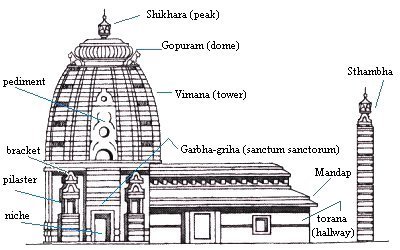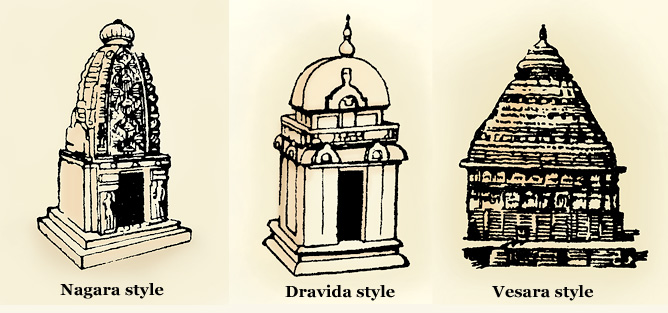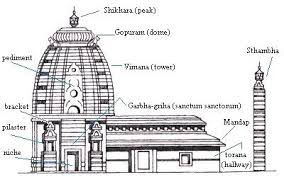-
Chapter 3: GUPTA ART AND ARCHITECTURE
Introduction
Art, architecture and literature flourished in the Guptan period. Canons of Brahmanical, Jainism and Buddhism were standardized in this period.
Religious tolerance was shown but Gupta kings were Brahmanical by religion. This period showed development of three deities in different regions:
1. Vishnu: North and Central India
2. Shiv: South India
3.
Shakti: Bengal
Cave Architecture:
Phase 1: Buddhism dominated this cave
architecture. Less permanent material like wood used.
Phase 2: Elimination of timber and
introduction of image of Buddha.
Phase 3: Hindus and Jains joined this
architectural tradition.
Ajanta Caves: UNESCO World Heritage Site. Aesthetic vision and advanced technical knowledge is seen. Entirely Buddhist influence. Most of the caves are viharas. Cave building was done in two phases:
1. Hinayana phase by Satvahana dynasty.
2. Mahayana buddhism under Vakataka rule. In Mahayana, Buddha isnt as important as Bodhisattva.
Ellora Caves: Has Hindu, Buddhist, Jain caves. Built during Kalachuri, Chalukya and Rashtrakuta dynasty.
Elephanta caves: UNESCO World Heritage
site. First group of caves is Hindu and second group is
Buddhist.
Temple Architecture:
Phase 1: Square temple with flat roof and shallow pillared hall. It is built on a low platform.
Phase 2: Square temple with flat roof. Its built on a higher platform and the Garbagriha is covered with an embulatory passage.
Phase 3: Built on higher platform with a Shikhar [Pyramidal roof above the Garbagriha]. Panchayatan style of Main shrine + 4 subsidiary shrines continued.
Phase 4: Rectangular temple with Shikhar and Panchayatan.
Phase 5: Circular temple with shallow rectangular projections.
Note:
An Hindu temple is a Panchayatana one when the main shrine is surrounded by four subsidiary shrines.
Ref: Wikipedia

Fig 1: Temple Components
Style of Temple Architecture:
1. Nagara style – Northern region
2. Dravida style – Southern region
3. Vesara style – Region between Vindhya and Krishna.

Fig 2: Temple
styles
Dravidian Architecture
- Mandap - Open pavillion excavated out of rock. Simple columned hall with two or more cells.
- Ratha – Monolithic shrine carved out of single rock
- Vimaan – Garbagriha and shikhar together. Single shikhar on main shrine.
- Gopuram – lofty gateways
- Dwarpals present instead of Mithuns as in Nagara style.
- Presence of tanks and pillared walls.
Functions:
Religious matters, administrative centres and control over vast tracts of land.
Dravidian style under Pallavas:
Stage 1: No real temple structure but only rock cut caves.
Stage 2: Decorations in rock cut caves and mandaps now became rathas.
Stage 3: Rajsimhanvarman style has real structural temples. Open air carving in relief on a rock surface.
Stage 4: Nandivarman style
has small temples.
Nagara Architecture
Curvilinear Shikhara. Square or rectangle temple. Garbagriha or panchayatan style. Pillared halls present but tanks absent.

Fig 3: Temple architecture [Ref: google.com]
Vesara Style of architecture
Chalukya style or Karnataka style. Fusion of nagara and Dravidian style. Carvings on pillars, ceilings and door plains. Chalukyan temples don’t have embulatory path.Hoysala school of art
Unique feature is star shaped ground plan
which has five points with five deities of equal
importance.
Temple pillars are monoliths. Intricate carvings on both sides of the walls and jewellery of gods.
Solved Question Papers
Q.With reference to art and archaeological history of India, which one among the following was made earliest? (UPSC CSAT 2015)
Lingaraja Temple at Bhubaneswar
Rock-cut Elephant at Dhauli
Rock-cut Monuments at Mahabalipuram
Varaha Image at Udayagiri
Ans . B
Lingaraja Temple at Bhubaneswar was created in 11th AD. Rock-cut Monuments at Mahabalipuram are 7th century AD creation. At Udayagiri, it is 5th century AD creation.
Rock-cut Elephant at Dhauli was created during Ashoka’s reign (272-231 BC).
Q.With reference to Indian history, which of the following is/are the essential elementary elements of the feudal system?
1. A very strong centralized political authority and a very weak provincial or local political authority
2. Emergence of administrative structure based on control and possession of land
3. Creation of lord-vassal relationship between the feudal lord and his overlord
Select the correct answer using the code given below. (UPSC CSAT 2015)
1 and 2 only
2 and 3 only
3 only
1, 2 and 3
Ans . B
Feudalism, in its various forms, usually emerged as a result of the decentralization of an empire
Feudalism and feudal system were a way of structuring society around relationships derived from the holding of land in exchange for service or labour
Quiz
Score more than 80% marks and move ahead else stay back and read again!